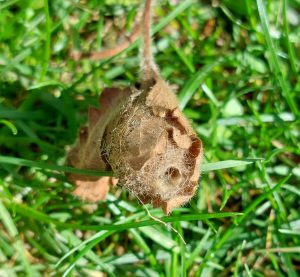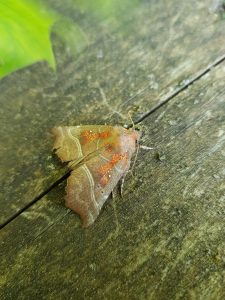Winter is quite a difficult time for pollinators. It is cold and often rainy and the first frosts will wipe out most of the flowers, and this will drastically reduce the availability of food. Pollinators have evolved various strategies to overcome this problem.
On the island of Ireland, we have over 100 wild bee species, 20% of which are bumblebees. Wild bees hibernate and overwinter as they haven’t evolved to store food (like the Honey bee) and there aren’t enough flowers across the winter.
Where do Bumblebees go in the winter?
Bumblebees are social bees and have nests and winter habits that revolve around their nest and queen. In early summer they live in a nest made up of a queen bee and female worker bees. As summer progresses, the queen lays eggs which produce a new generation of queen bees and male bees.
The new queen and males leave the nest and try to find mates, with the new queens then gorging on nectar and pollen to build up fat in their bodies. Eventually the new queens hibernate alone underground, with their critical fat stores helping them survive through the winter. The rest of the nest – including the old queen, the male bees and female workers, die out throughout the autumn.
Hibernation sites vary, they include soil banks and slopes and prefer shaded north-west facing sites. There have also been reports of hibernation sites in soft potting compost in plant pots, wood piles and even in compost heaps.
If you find a queen bumblebee whilst repotting plants, just put everything back the way it was, so she can continue her winter sleep.
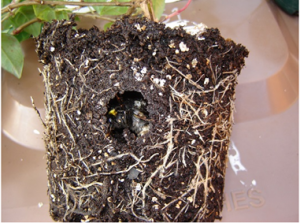
In the spring, the warmer temperatures wake the queens from their hibernation, and they’ll seek nectar to feed on, before finding a suitable nest site for the year. Having already mated before they hibernated, they’ll lay their 1st brood of eggs, which will produce female worker bees.
Are changes in climate affecting hibernation patterns?
In milder climates, one bumblebee called the Buff-tailed bumblebee, has been known to remain active through the winter, foraging on winter blooming shrubs. This can include Ivy and Willow, and in our gardens, this can include plants such as Mahonia and Hellebore. It is unclear whether this winter brood successfully breeds in Ireland.
Where do solitary bees go in the winter?
Most of our wild bee species are solitary. Solitary bees are highly diverse, and so are their overwintering habits. Most solitary bees have an annual life cycle, with the female gathering pollen and nectar for the nest where they lay their eggs. They then seal the nest which contains their eggs, and pollen and nectar for young bees to eat in order to develop into adults. During the winter months the eggs become larvae and eventually turn in to young bees. The life cycle for most solitary bee species is very short, lasting for a few weeks to a month, and this means they never get to see their young.
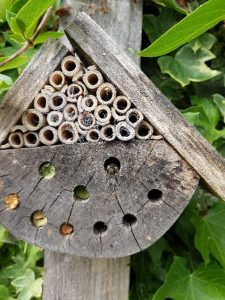
Some species of solitary bee spend the winter as adults protecting themselves from the cold in a process called overwintering. Mining bees, such as the Ashy (or Grey) Mining bee, remain underground as adults in their nest cells. They then emerge in spring to make the most of early blooms. Other species, like the leafcutter bees, spend the winter as pupae and have an annual lifecycle that ends after they lay their eggs in the autumn.
Some of the tiny solitary bees may overwinter in hollow plant stems, so it’s always good to leave some plant stems undisturbed over the winter months.
Where do Hoverflies go in the winter?
We have around 180 different types of hoverflies in Ireland. Their life cycle varies and depends on environmental conditions and food availability. They have two strategies to survive in the winter. They either hide in the soil as fully-grown larvae or they hibernate as adults in sheltered places such as the nooks and crannies of old trees.
Hoverflies overwintering as adults are the ones you see flying around on the first warm days in spring. The hoverflies whose larvae eat aphids will be searching for aphid-infested plants to lay their eggs on. Later in the season, they are joined by the newly emerged hoverflies of those species that overwinter as larvae.
Species that overwinter as larvae also live in dead wood and some in stagnant water rich in organic material.
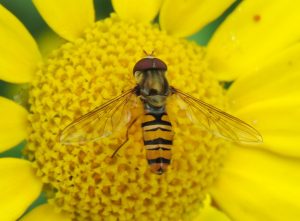
Where do moths go in the winter?
Moths have a range of strategies to survive winter. Depending on the species they can overwinter as an egg, a caterpillar, a chrysalis (pupa), an overwintering adult moth or as an active adult moth.
Moths that overwinter as pupae, spend winter in warm cocoons underground or amongst plant and leaf litter.
The adults of a few moths remain active during the winter. They have evolved the capability to produce an anti-freeze agent, which stops ice-crystals forming in their ‘blood’ if temperatures are below 0oC.
Connecting it all together on farmland
It’s always good to keep in mind that our native hedgerows, field margins and buffer strips can be important in allowing pollinator species to move between habitats. These wildlife corridors include woodland, scrub, ponds and tussocky grassland, and can provide places to feed, migrate, take refuge and hibernate.
So, when wild bees, hoverflies and moths reappear in the new year, we should celebrate the ingenious ways they have of surviving the winter and take steps to give them the habitat they need to thrive.
Find out more about our pollinators:
Learn how to Identify, record and monitor Irish Bumblebees https://learn.biodiversityireland.ie/courses/commonbumblebees
Learn how to identify Ireland’s common farmland hoverflies https://learn.biodiversityireland.ie/courses/farmlandhoverflies
How-to-guide, Create wild pollinator nesting habitat Pollinator-Nesting-How-to-Guide-2022-WEB.pdf (pollinators.ie)
By Ruth Wilson, Farmland Pollinator Officer, All-Ireland Pollinator Plan

